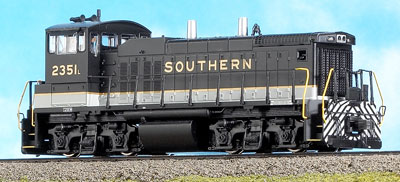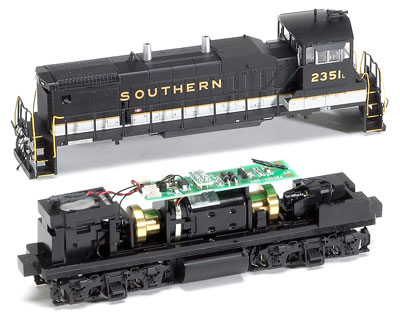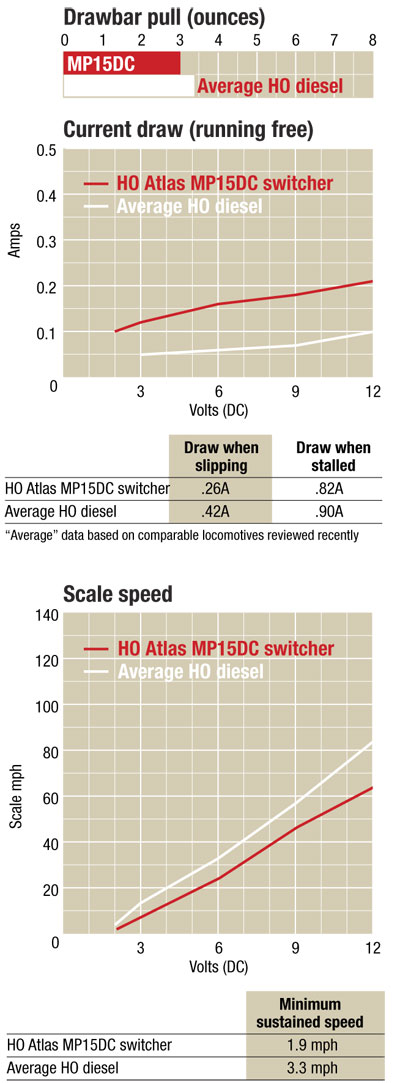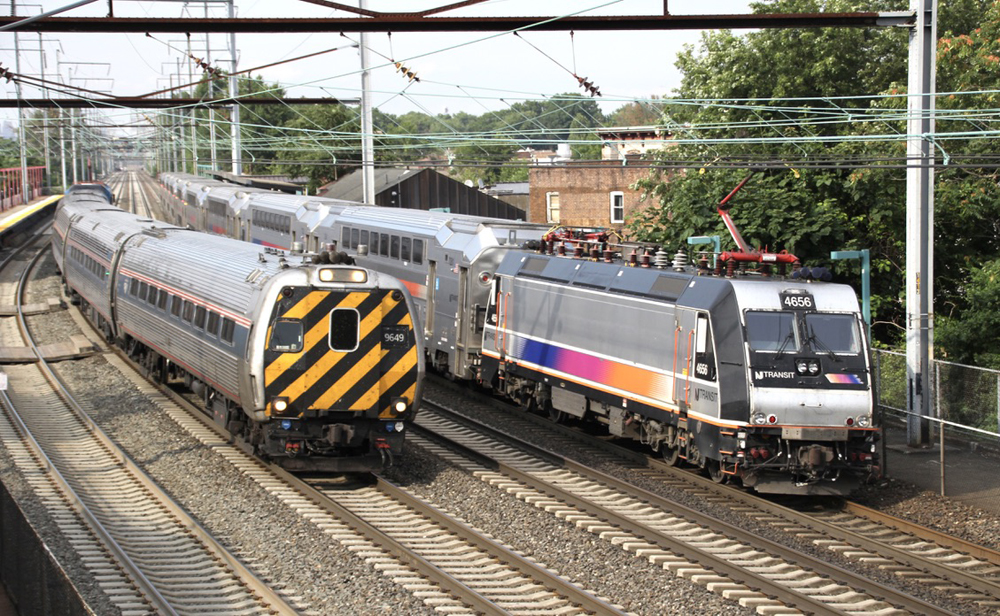Replacement power. Electro-Motive Division introduced the 1,500-hp MP15 in 1974 as a replacement for the company’s successful SW1500 switcher. The new unit’s MP designation indicated it was a multipurpose locomotive. Built on a frame longer than the SW1500’s, the MP15 carried more fuel and rode on GP-type road trucks that allowed it to operate at road speeds up to 65 mph.
The first MP15s were built for the Missouri Pacific in February 1974, and 351 units were ultimately produced. The last one was built in January of 1983. This locomotive had a DC electrical system, so its model designation was changed to MP15DC in 1975 when EMD introduced the similar MP15AC with an alternator.
Prototype plans of the MP15DC were published in the Model Railroader Cyclopedia: Vol. 2, Diesel Locomotives. The Atlas model matches these plans.
The versatile MP15DC locomotive is owned by railroads across North America and was also purchased by a number of industrial customers for plant switching.
Details abound. The Atlas MP15s are offered with a wide variety of railroad-specific details. The plastic carbody is assembled from many optional parts that allow Atlas to customize the MP15 for each prototype. A one-piece sill casting includes the basic pilots, side sills, and running boards. The hood, cab base, and cab are separate pieces that snap-lock into the sill casting, and then the unit is finished off with the appropriate detail parts.
The decoration on our sample Southern Ry. locomotive is excellent. Its paint was smooth and the printed lettering was all clear and readable, including the realistic tiny red “DANGER 600 VOLTS” labels. Three printed instruction sheets contain exploded-view isometric drawings that show where the optional user-applied parts belong. Gold-series models also include an instruction book covering the use of QSI’s built-in sound and dual-mode DCC system.
The isometric drawings provide some insight into what it takes to achieve all the different versions of the MP15. Three different castings provide either a standard tapered hood, one with a square air filter box, and a third with an angled air filter box. These filter boxes sit on top of the hood between the rear stack and the cab.
Other factory applied details include several styles of sandboxes, exhaust stacks (with or without a muffler), snowplows, and a cab interior with a painted crew.
Separate radiator grills on the hood add nice three-dimensional, see-through effects to the model’s cooling system. Both pilots are detailed with brake hoses, m.u. cables, uncoupling levers, and optional snowplows.
Acetal plastic gearboxes drive all of the axles. The nickel-silver wheels have RP-25 contours and match the National Model Railroad Association standards gauge.
The wheelsets have split axles that ride in electrical pickups concealed inside the sideframes, so all the wheels collect current. Both trucks are hard-wired to the printed-circuit (PC) board that holds the electronic components.
Our sample MP15 is a Silver-series DC model that includes an NMRA-recommended 8-pin plug for easy conversion to DCC. Gold-series units with QSI sound have a different PC board in the same location plus a speaker mounted on a bracket over the front truck.
This late-model, heavy-duty switcher offers a great combination of superb prototype-specific details and smooth performance.
Price: $134.95 Silver-series DC only, $244.95 Gold-series with sound and DCC decoder
Manufacturer
Atlas Model Railroad Co.
378 Florence Ave.
Hillside, NJ 07205
Description
Plastic and metal ready-to-run diesel switcher
Road names
2 unit numbers and unnumbered versions each, with our without DCC and sound: Belt Ry. of Chicago* (black and gray), or Bicentennial no. 534), Chicago & North Western, Conrail*, CSX, Genesee & Wyoming, Louisville & Nashville*, Missouri Pacific (blue*, or yellow and gray), Reading (dark green), St. Louis-San Francisco*, Southern Ry., Southern Pacific, Union Pacific*, Union RR*, and undecorated (angled filter box, square filter box, or standard hood* versions)
*Due out in July 2006
Accumate knuckle magnetic couplers mounted at the proper height
All-wheel drive and electrical pickup
Constant directional headlights
DC-only (Silver-series) version includes an automatic dual-mode decoder with QSI Quantum sound system that operates both DC and DCC systems
Drawbar pull: 3.04 ounces
Engine weight: 9.5 ounces
Five-pole skew wound motor with dual brass flywheels
Illuminated number boxes
Minimum radius: 15″
Nickel-silver RP-25 contour scale 40″-diameter wheels (correctly gauged)
Prototype-specific details
















